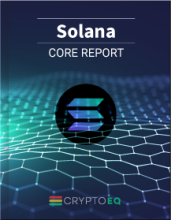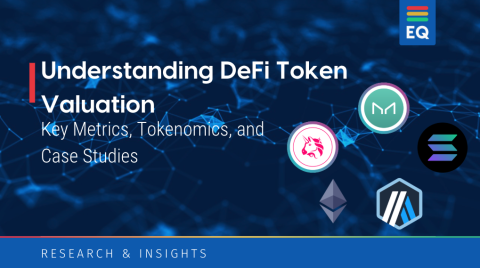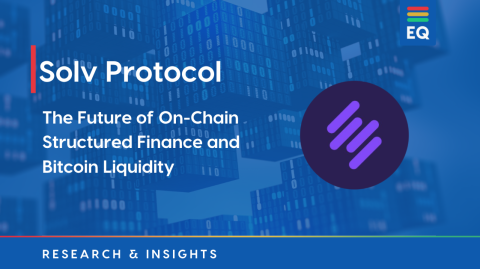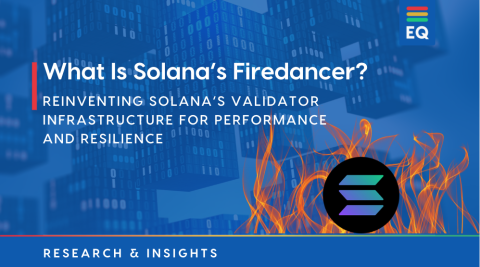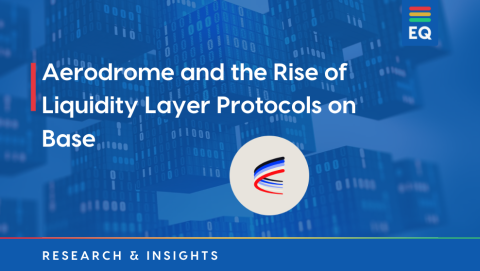How Decentralized Infrastructure (DePIN) is Paving the Way for a New Era in Cryptocurrency
Testimonials
We have received a tremendous amount of value from the research services provided by CryptoEQ! I can’t think of any other source in the digital asset space that provides the same caliber of detailed analysis or such a comprehensive unbiased set of insights. CryptoEQ’s 360° due diligence process is second to none in the industry!
— Baxter Hines, Chief Investment Officer at Honeycomb Digital Investments
CORE Research Audio
Related CORE Reports

Author: CryptoEQ Team
Published: 1/8/2024
Summary
Decentralized Physical Infrastructure (DePIN) networks represent a transformative advancement in the cryptocurrency industry, redefining the development and deployment of real-world assets through blockchain technology. This article delves into the concept of DePIN, exploring its advantages, design considerations, participant engagement strategies, governance, sustainability, and interplay with traditional market players. It provides an in-depth analysis of the potential of DePIN networks to reshape traditional infrastructure models and offer new, efficient, and decentralized solutions.
Table of Contents
Introduction
Decentralized Physical Infrastructure (DePIN) is a groundbreaking concept that is revolutionizing the cryptocurrency industry. This article explores the significance of DePIN and how it is paving the way for a new era in cryptocurrency.
At its core, DePIN refers to blockchain-based physical infrastructure networks that leverage tokens to incentivize and reward contributors. These networks enable the construction of real-world infrastructure through verifiable work, offering a decentralized model that promotes open competition, innovation, and lower costs.
The aim of this article is to delve into the various aspects of DePIN networks and shed light on their potential impact on the cryptocurrency landscape.
The key topics covered in this article include:
- The Advantages and Categories of DePIN Networks: We will explore the benefits offered by DePIN networks, such as increased speed, cost-effectiveness, and a focus on hyper-local markets. Additionally, we will delve into different categories of DePIN networks, including energy, logistics, mapping, and telecom, providing relevant examples.
- Designing Robust DePIN Networks: In this section, we will discuss important considerations for designing effective DePIN networks, such as involving both consumer and professional hardware installers for widespread adoption. We will also explore the trade-offs between permissionless and trusted intermediaries models and propose strategies for mitigating challenges related to hardware installation complexity.
- Engaging Participants in the DePIN Ecosystem: Here, we will advocate for open sourcing hardware specifications to encourage innovation and interoperability within DePIN networks. Furthermore, we will discuss strategies for driving demand and community involvement through education, marketing efforts, and targeted pilot projects.
- Governance and Sustainability in DePIN Networks: We will explore different approaches to token incentives and reward mechanisms in DePIN networks, emphasizing the importance of balancing long-term sustainability and short-term network growth. We will also propose a framework for utilization-based token distribution that takes into account actual usage and contribution to the network's utility.
- The Interplay Between DePIN Networks and Traditional Market Players: This section will examine the potential collaboration or competition dynamics between DePIN networks and traditional infrastructure providers, with a specific focus on value-added resellers (VARs) as intermediaries within the ecosystem.
- The Future Trajectory of DePIN in the Cryptocurrency Landscape: Finally, we will assess the current state and future potential of DePIN networks in driving innovation and efficiency in the broader cryptocurrency industry. We will examine their role in reshaping traditional infrastructure models and providing gig economy-like revenue opportunities for contributors.
By exploring these key topics, this article aims to provide a comprehensive understanding of DePIN networks and their transformative potential in the world of cryptocurrency.
Understanding Decentralized Physical Infrastructure (DePIN)
Decentralized Physical Infrastructure (DePIN) networks have emerged as a groundbreaking concept in the cryptocurrency industry. To comprehend the significance of DePIN networks, it is essential to explore the origins and evolution of this transformative approach.
Key Drivers: Incentives in DePIN Networks
One of the key drivers behind DePIN networks is the role of incentives. Incentives play a crucial role in motivating participants to contribute their resources and efforts toward building real-world infrastructure.
- By rewarding contributors with network tokens or other forms of value, DePIN networks create a system where individuals are motivated to engage in verifiable work.
- The incentive structure within DePIN networks aligns economic incentives with the desired outcome of building decentralized physical infrastructure.
- This approach not only drives innovation but also ensures that there is a tangible benefit for participants in contributing their resources.
The Advantages and Categories of DePIN Networks
DePIN networks have several key benefits that make them stand out from traditional infrastructure models. These benefits include:
1. Increased Speed
DePIN networks use blockchain technology and token incentives to encourage people to contribute to building real-world infrastructure. This decentralized approach allows infrastructure projects to be completed much faster than usual, anywhere from 10 to 100 times faster!
2. Cost-Effectiveness
By leveraging decentralized physical infrastructure, DePIN networks can greatly reduce the cost of constructing and managing infrastructure. They achieve this by using cryptocurrency-based funding, which eliminates the need for expensive middlemen and lowers operational expenses.
3. Hyper-Local Market Focus
DePIN networks are designed specifically for local markets, ensuring that infrastructure resources are allocated where they are most needed. This localized approach means that communities can enjoy better access to essential services without depending on centralized providers.
DePIN Network Categories
DePIN networks cover different areas of the cryptocurrency ecosystem, each with its own purpose. Here are some of the main categories:
Logistics
DePIN logistics networks streamline supply chain operations by using blockchain technology to improve transparency and optimize resource allocation. These networks enhance coordination among different parties in the logistics industry, resulting in better efficiency and lower expenses.
Mapping
DePIN mapping networks gather accurate and trustworthy data from various sources to enhance mapping capabilities and data integrity. They employ distributed sensor networks to collect information that can be used for tasks like creating real-time maps or monitoring the environment.
Telecom
DePIN telecom networks strive to make internet access more democratic by establishing decentralized hotspot networks. These networks offer affordable connectivity options, support advanced technologies like 5G and LoRaWAN, and decrease reliance on centralized telecom providers.
Examples of DePIN networks in action include:
- Hivemapper, which rewards drivers with tokens for collecting mapping data using dashcams.
- Helium, which allows node runners to earn income by hosting hotspots for mobile connectivity.
By focusing on these advantages and categories, DePIN networks are leading the way toward a new era in cryptocurrency by transforming the development and implementation of physical infrastructure.
Designing Robust DePIN Networks
When it comes to designing robust DePIN networks, several key considerations must be taken into account. These considerations include:
Involving Consumer and Professional Hardware Installers
Ensuring widespread adoption and expertise within DePIN networks requires the involvement of both consumer and professional hardware installers.
- Consumer hardware installers: Individuals who install and maintain the necessary hardware on their own.
- Professional hardware installers: Trained experts who provide installation services to users.
By involving both types of installers, DePIN networks can benefit from a diverse pool of contributors, ensuring a wider reach and expertise within the network.
Trade-Offs Between Permissionless and Trusted Intermediaries Models
DePIN networks have the option to adopt either permissionless or trusted intermediaries models.
- Permissionless models: Allow anyone to participate as a node operator or contributor without any restrictions, promoting open competition and innovation.
- Trusted intermediaries models: Involve pre-approved entities or individuals who act as gatekeepers to ensure higher levels of trust and security within the network.
A hybrid approach that combines elements from both models can be recommended depending on the specific needs and objectives of each DePIN network.
Addressing Hardware Installation Complexity and Scaling Challenges
The complexity of hardware installation can pose challenges to the scalability of DePIN networks. Different types of DePIN networks may require varying levels of installation expertise and effort.
- For example, setting up a Helium hotspot for decentralized wireless connectivity may be relatively simple and straightforward, while installing geographically-distributed GPUs for compute networks may be more complex and time-consuming.
To mitigate these challenges:
- Provide detailed installation guides.
- Offer professional installation services.
- Simplify the hardware setup process through technological advancements.
By considering these factors in the design phase, DePIN networks can be built to be more robust and efficient, enabling them to realize their full potential in revolutionizing the cryptocurrency landscape.
Engaging Participants in the DePIN Ecosystem
Engaging participants is crucial for the success of DePIN networks. Here are some key strategies to foster engagement and drive community involvement:
Advocating for open-sourcing of hardware specifications
Open-sourcing hardware specifications encourage innovation and interoperability within DePIN networks. By making hardware specifications freely available, it enables a wider range of participants to contribute and build upon existing designs. This approach fosters collaboration and allows for continuous improvements in hardware technology.
Achieving threshold-scale engagement
To unlock the full potential of DePIN networks, it is essential to achieve threshold-scale engagement from both active builders and passive users. The threshold scale refers to the minimum level of engagement necessary to ensure the network's viability and sustainability. This can be achieved by incentivizing participation through token rewards or other mechanisms, thereby attracting a critical mass of participants.
Driving demand through education and marketing efforts
Education plays a vital role in increasing awareness and understanding of DePIN networks. By providing educational resources such as tutorials, webinars, and documentation, potential participants can learn about the benefits and opportunities offered by DePIN networks. Marketing efforts can also help create buzz and attract attention to specific projects or initiatives within the ecosystem.
Pilot projects in targeted locations
Conducting pilot projects in specific locations can help validate the feasibility and effectiveness of DePIN networks. These pilot projects serve as real-world demonstrations of the capabilities and benefits of decentralized infrastructure. They also allow for iterative improvements based on feedback from participants, enabling the fine-tuning of network operations.
By implementing these strategies, DePIN networks can foster a vibrant ecosystem with active engagement from both professionals and retail contributors, leading to widespread adoption and continued growth.
Governance and Sustainability in DePIN Networks
When it comes to DePIN networks, one of the key considerations is finding the right balance between long-term sustainability and short-term network growth. This involves designing token incentives and reward mechanisms that encourage participation and contribution from network participants.
The Role of Time-Based Token Emissions
One approach that has been widely utilized in various blockchain networks is the concept of time-based token emissions. This means that tokens are gradually released into circulation over a specified period of time. The idea behind this is to align incentives with the time value of infrastructure services provided within DePIN networks.
Gradually releasing tokens creates an incentive for network participants to hold onto their tokens for a longer period of time, as they anticipate potential future value appreciation. This can help in attracting long-term supporters and reducing short-term speculation.
Utilization-Based Token Distribution Framework
Another approach to consider is a utilization-based token distribution framework. Instead of solely relying on time-based emissions, this framework takes into account the actual usage and contribution to the network's utility.
Under this framework, tokens are distributed based on factors such as:
- Amount of data transferred or stored within the network
- Number of transactions processed
- Level of participation in consensus mechanisms
By rewarding participants based on their actual utilization and contribution, it creates a direct link between network performance and token distribution. This can incentivize active participation and ensure that tokens are allocated to those who actively contribute to the network's growth.
In conclusion, when it comes to governance and sustainability in DePIN networks, there are different approaches to consider when designing token incentives and reward mechanisms. By exploring options such as time-based emissions and utilization-based frameworks, we can aim to create a sustainable ecosystem that balances both short-term growth and long-term sustainability.
The Interplay Between DePIN Networks and Traditional Market Players
When it comes to the relationship between DePIN networks and traditional market players like value-added resellers (VARs), there are a few key points to consider:
The Role of VARs in the Ecosystem
VARs are intermediaries who take resources from DePIN networks and create customized products or services for their customers. This means they have the power to shape how customers interact with DePIN networks.
Potential for Collaboration or Competition
The involvement of VARs can go two ways:
- Collaboration: VARs could see the value in working together with both DePIN networks and traditional infrastructure providers. By doing so, they can offer a wider range of solutions to their customers.
- Competition: On the other hand, VARs may view DePIN networks as competitors, especially if they start offering similar products or services. This could lead to a more strained relationship between the different players in the ecosystem.
Strategic Responses from Traditional Market Players
Lastly, it's important to consider how traditional market players perceive DePIN networks. If they see them as potential threats to their business, they may respond strategically in order to protect their market share.
By understanding these dynamics between DePIN networks and traditional market players, we can get a better idea of how the cryptocurrency industry as a whole might evolve in the future.
The Future Trajectory of DePIN in the Cryptocurrency Landscape
As we assess the current state and future potential of DePIN networks in driving innovation and efficiency in the broader cryptocurrency industry, it is important to consider the role of projects like Filecoin and Storj. These projects have been instrumental in addressing the storage needs of decentralized infrastructure networks, including DePIN networks. However, they also face challenges in terms of cost competitiveness and scalability.
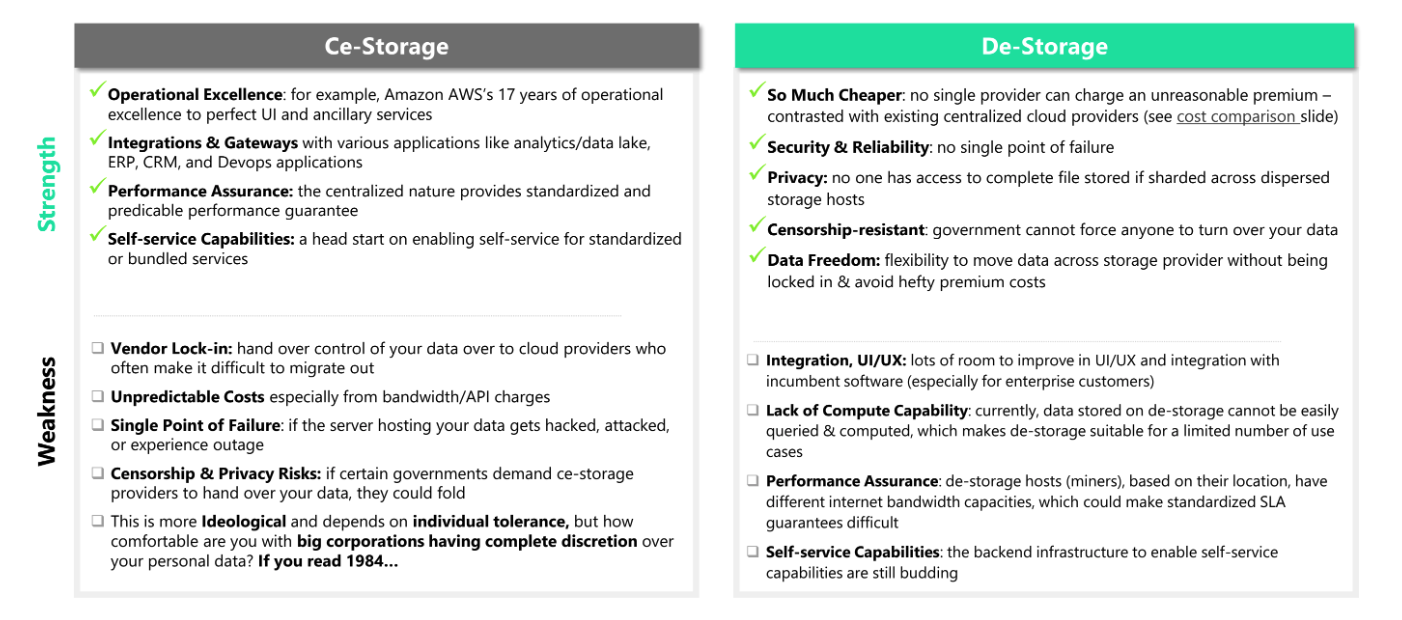
The Role of Filecoin and Storj in DePIN Networks
Filecoin and Storj are both decentralized storage platforms that leverage blockchain technology to provide secure and distributed storage solutions. They enable individuals and organizations to rent out their unused storage space and earn tokens in return. These tokens can then be used to access storage services or traded on cryptocurrency exchanges.
While these projects have made significant strides in addressing the storage needs of DePIN networks, there are still some challenges to overcome. One such challenge is cost competitiveness. As more participants join these networks, the cost of storing data can increase, making it less attractive for users compared to traditional centralized storage providers.
Scalability is another area of concern for these projects. As the demand for storage continues to grow, it becomes crucial for Filecoin, Storj, and similar platforms to ensure that their infrastructure can handle the increasing workload without compromising performance or security.
Blockchain Platforms Suitable for DePIN Projects
In terms of blockchain platforms suitable for DePIN projects, Solana has emerged as a popular choice. Solana offers low transaction costs and high throughput, making it well-suited for applications that require fast and efficient processing. Additionally, Solana has a high Nakamoto Coefficient, indicating a strong level of decentralization and security.
The Potential Impact of DePIN Networks
As we look ahead, it is evident that DePIN networks have the potential to reshape the traditional infrastructure models and provide gig economy-like revenue opportunities. By leveraging token incentives and blockchain technology, these networks offer distinct advantages such as:
- Open competition
- Lower costs
- Incentivized development
- A sharing economy model
The Promising Future of DePIN Networks
In conclusion, the future trajectory of DePIN in the cryptocurrency landscape is promising. With continued innovation and advancements in blockchain technology, we can expect significant developments in both physical infrastructure and the broader cryptocurrency industry. DePIN networks have the potential to emerge as major players, driving efficiency and innovation in various sectors.
Conclusion
Decentralized Physical Infrastructure (DePIN) networks have the potential to revolutionize the way we build and interact with real-world assets in the cryptocurrency landscape. These networks offer a decentralized model that promotes open competition, innovation, and lower costs through token rewards and blockchain technology.
As we look to the future, it is clear that DePIN networks will play a significant role in driving efficiency and innovation in the broader cryptocurrency industry. Projects like Filecoin and Storj have already made strides in addressing the storage needs of DePIN networks. However, challenges remain in terms of cost competitiveness and scalability.
DePIN...Check. Solana?
Don't worry, click here!
